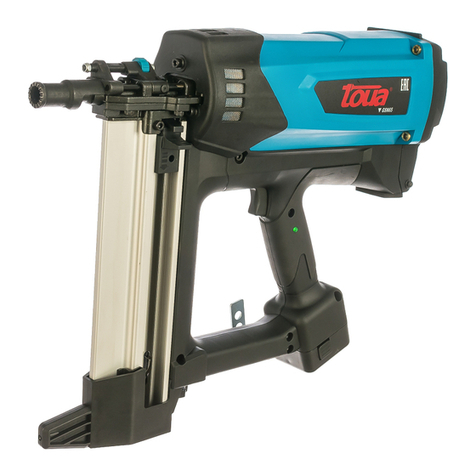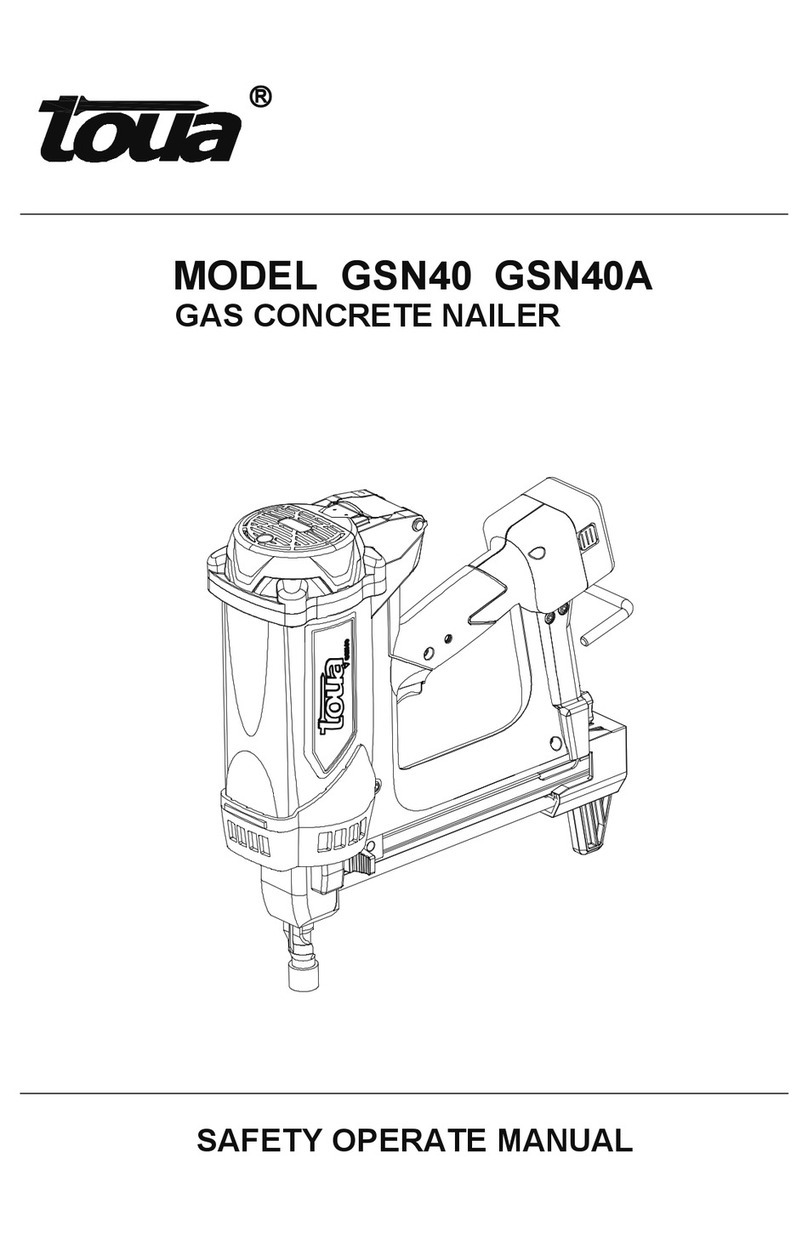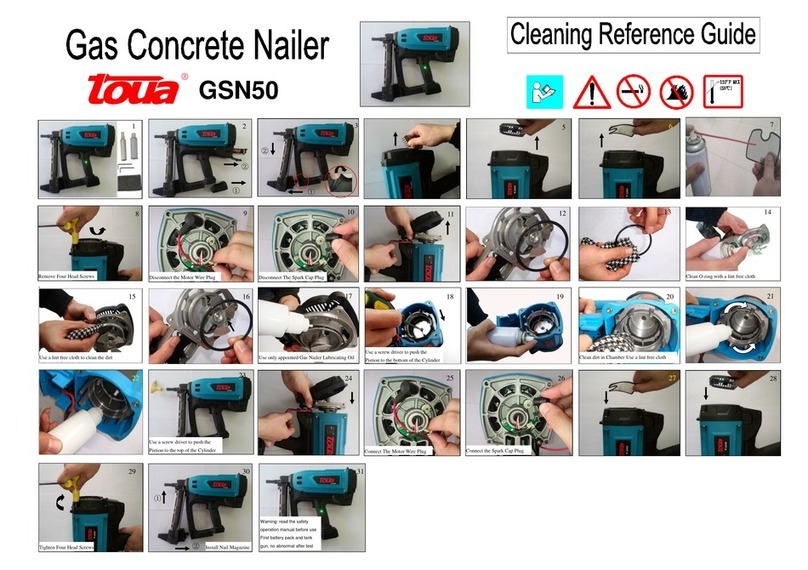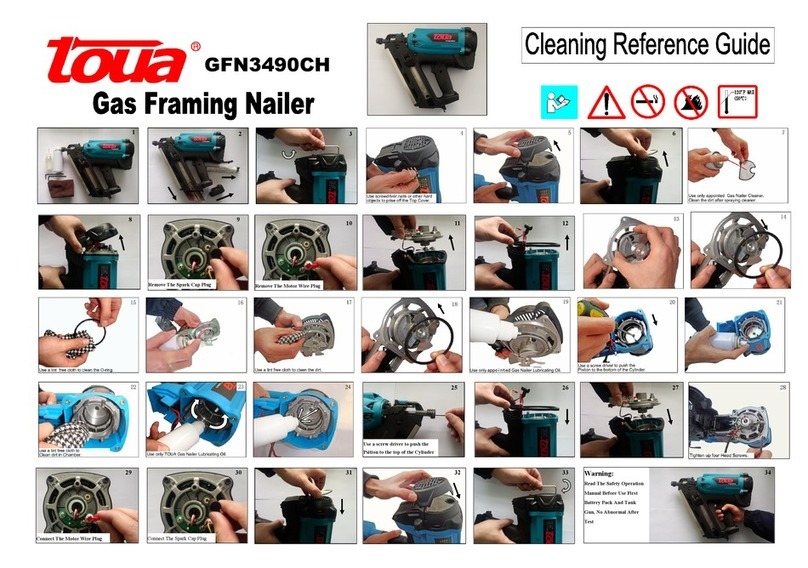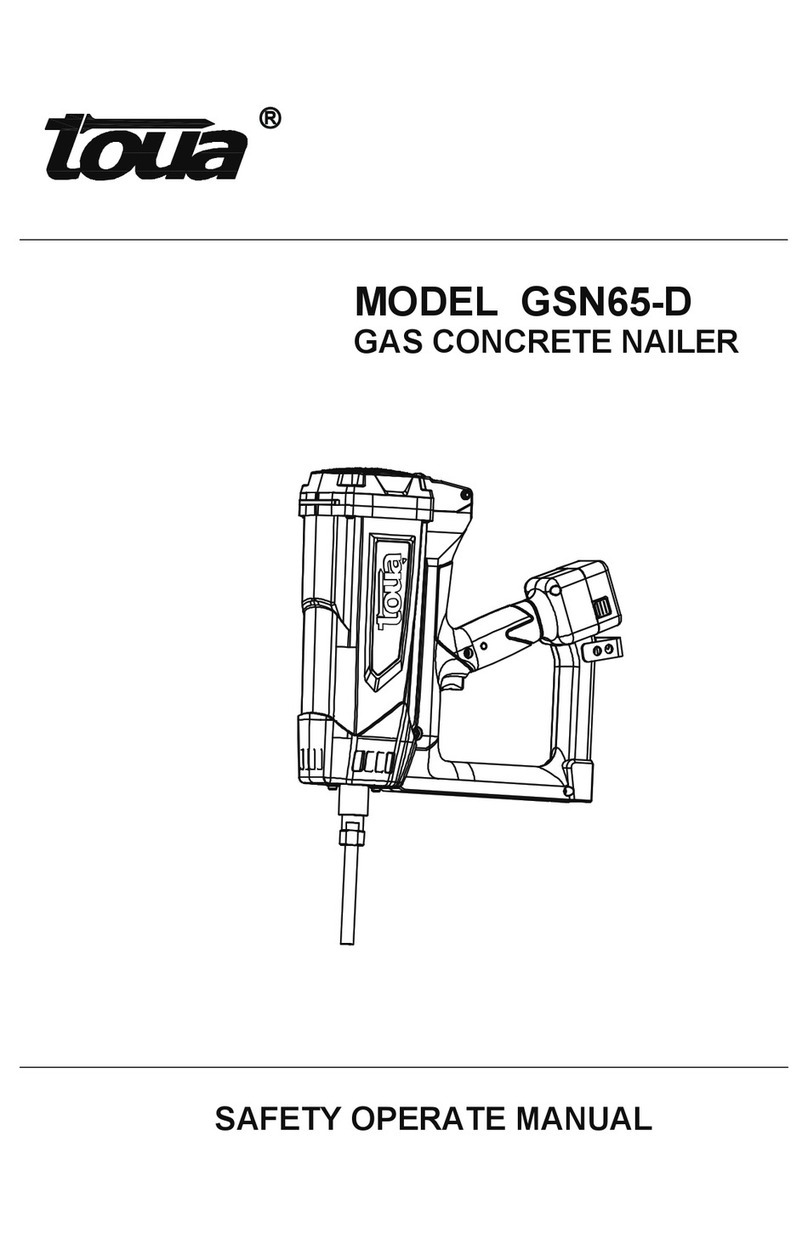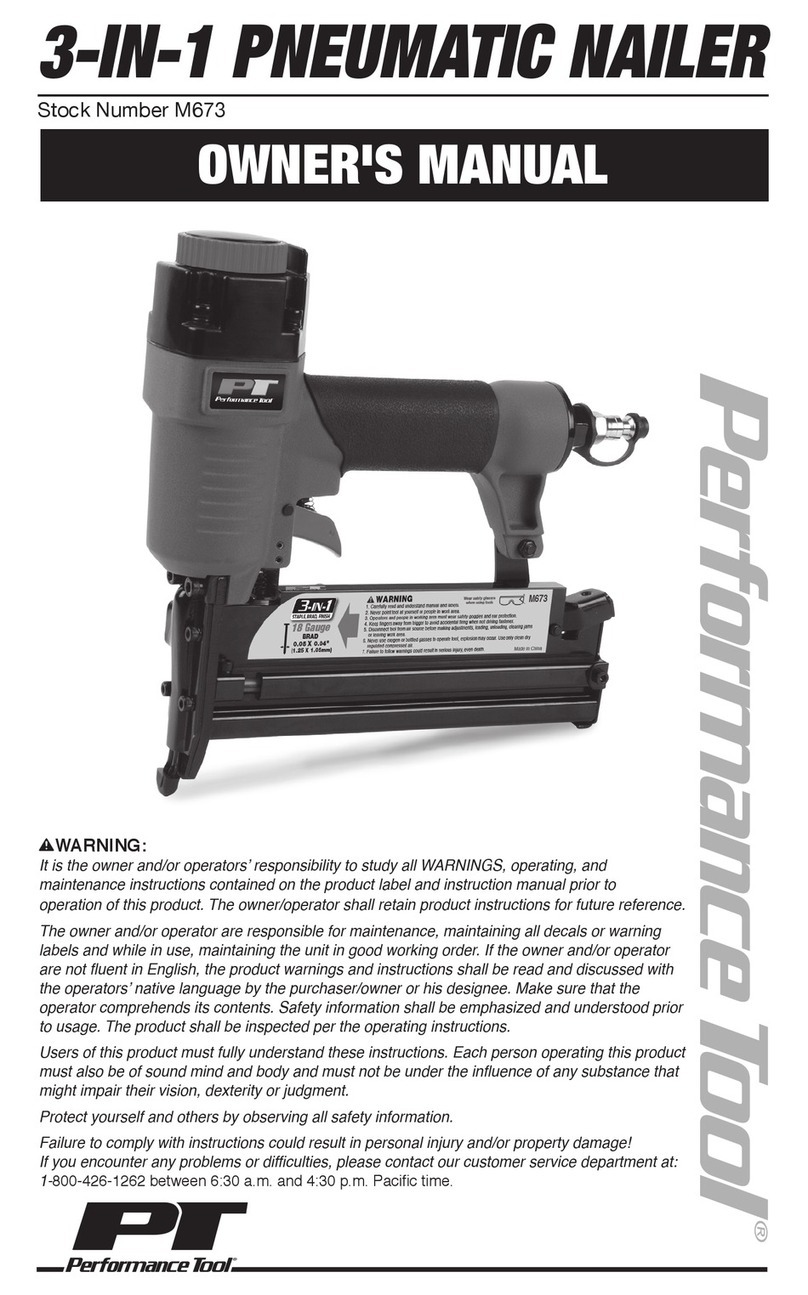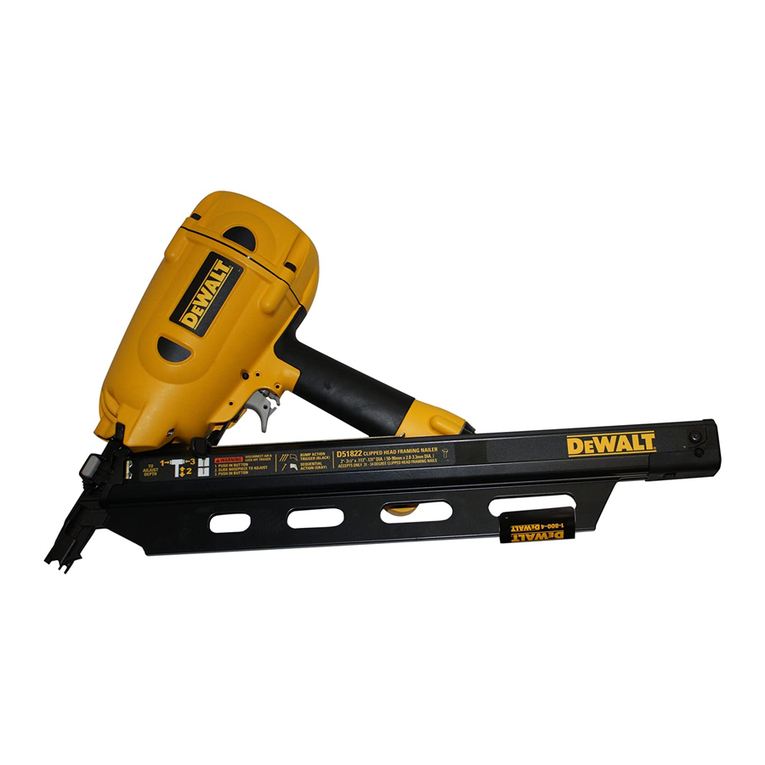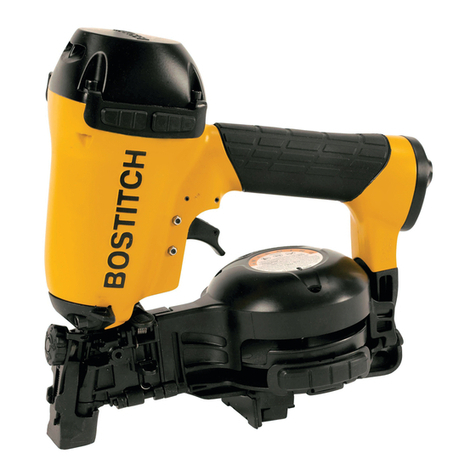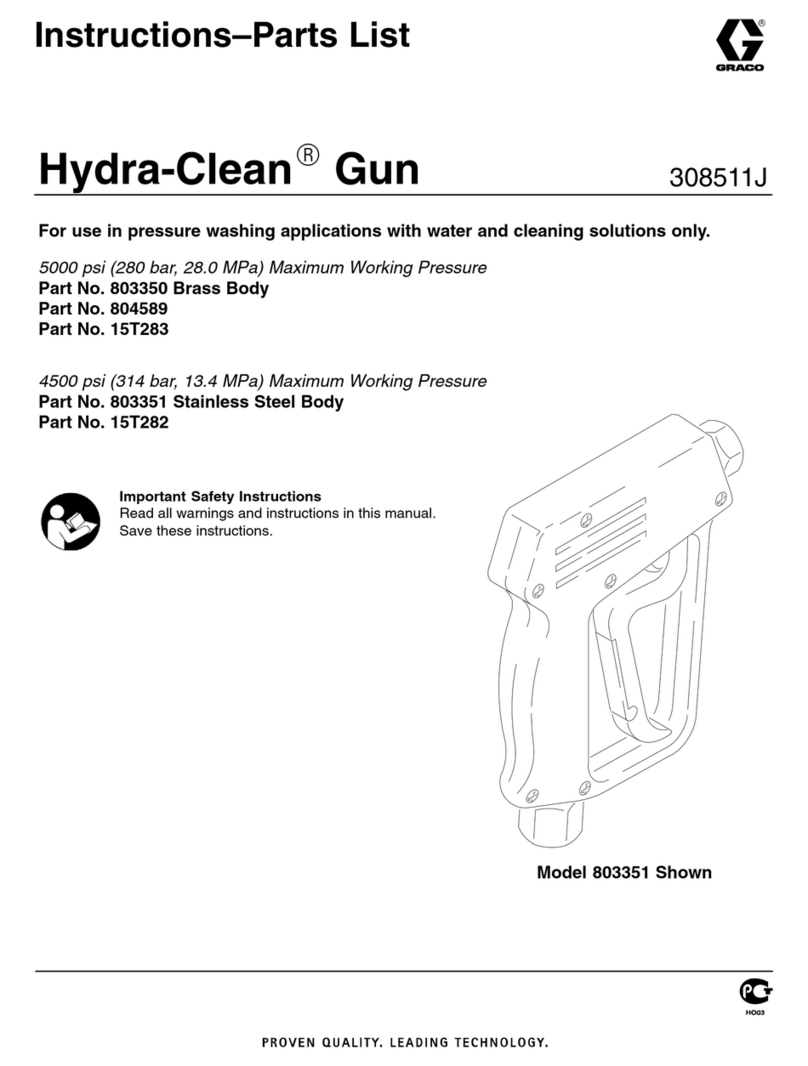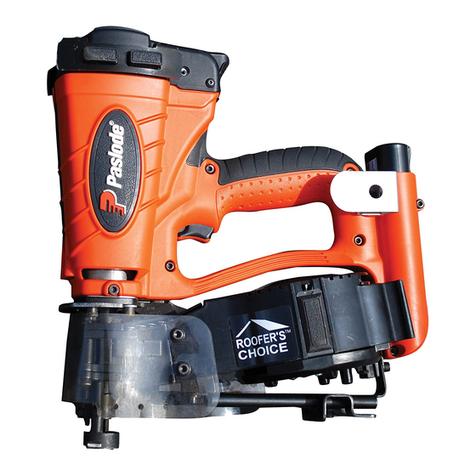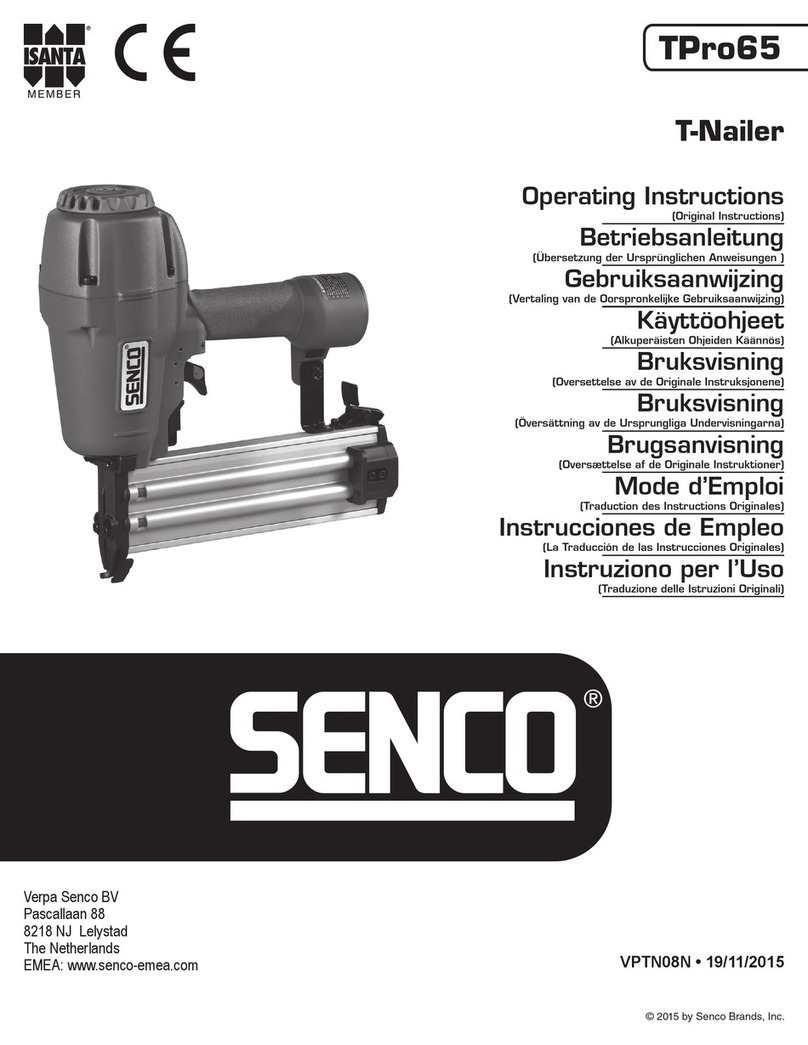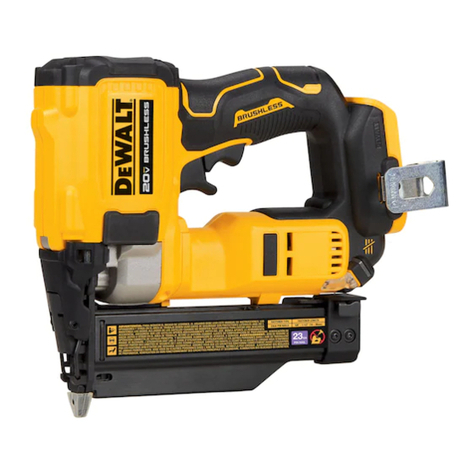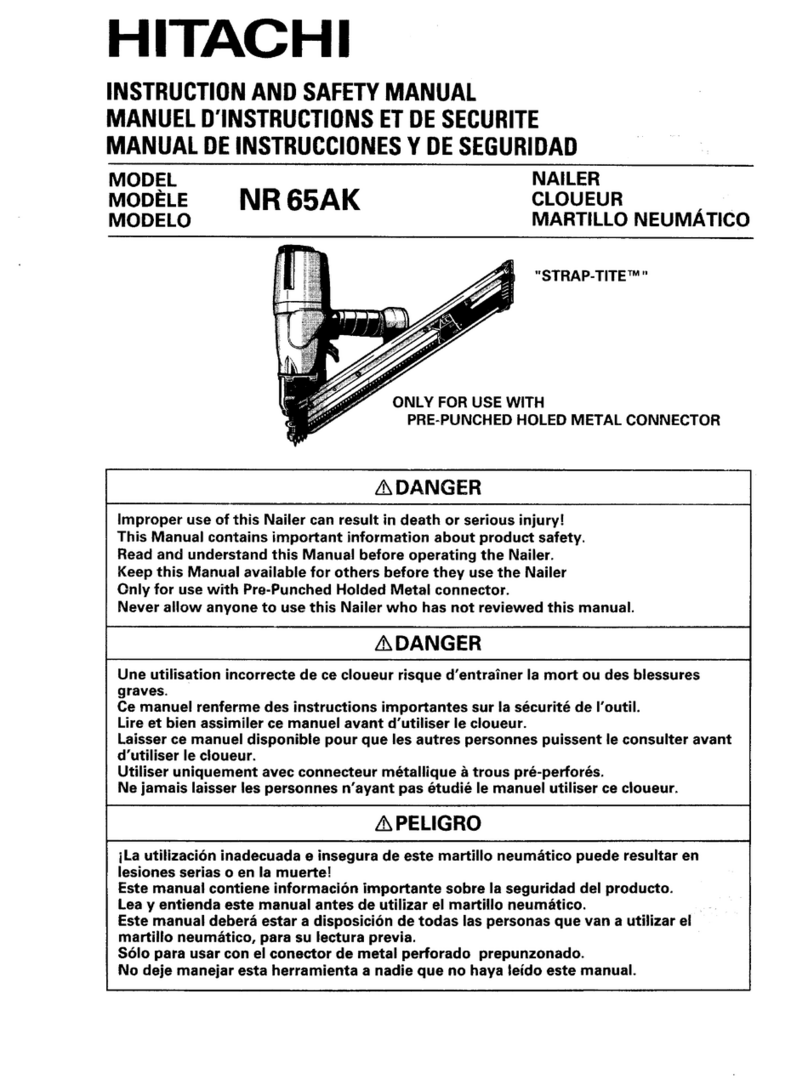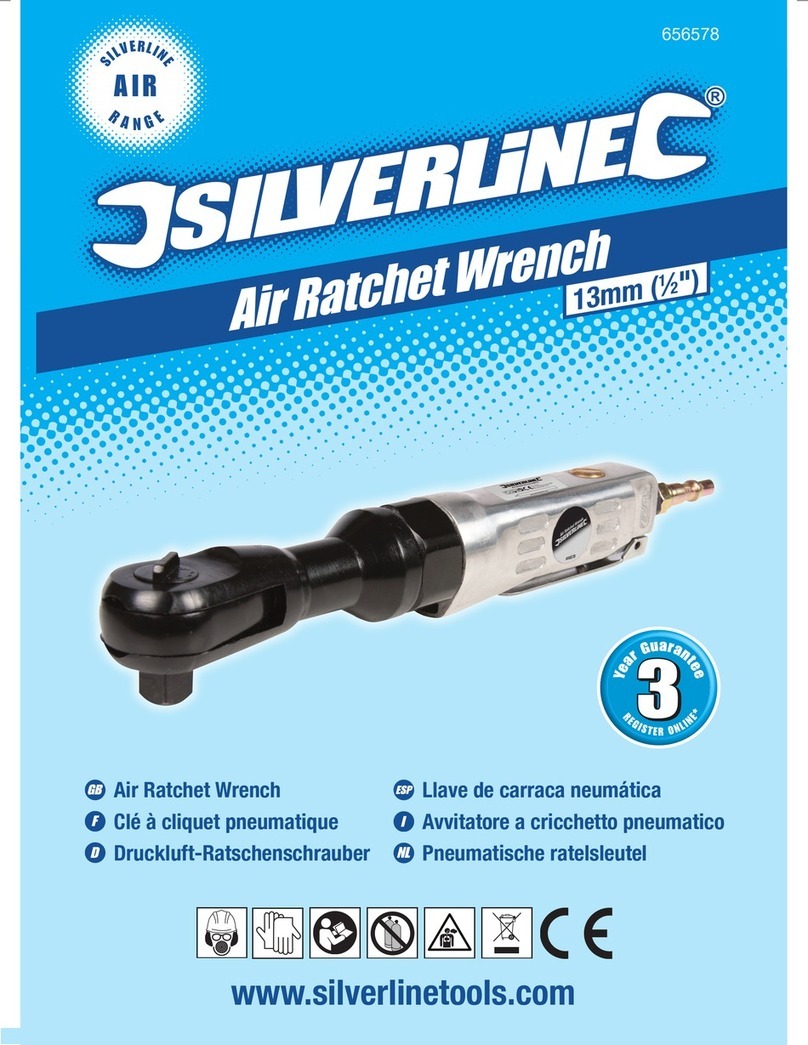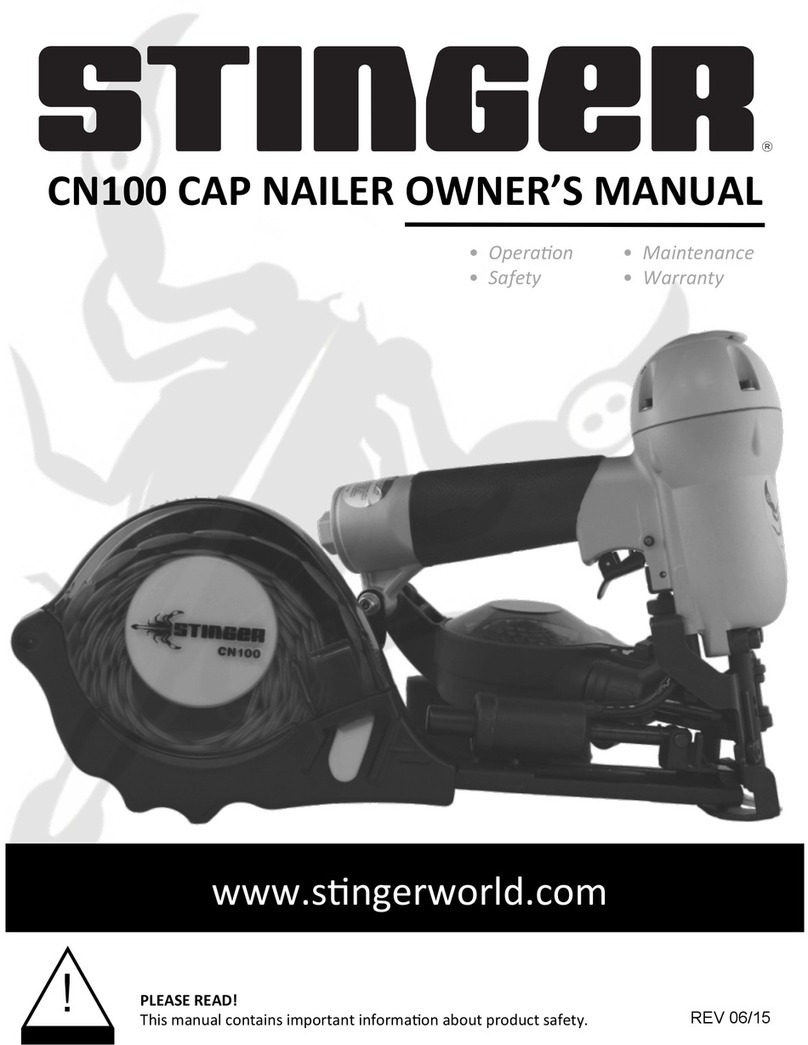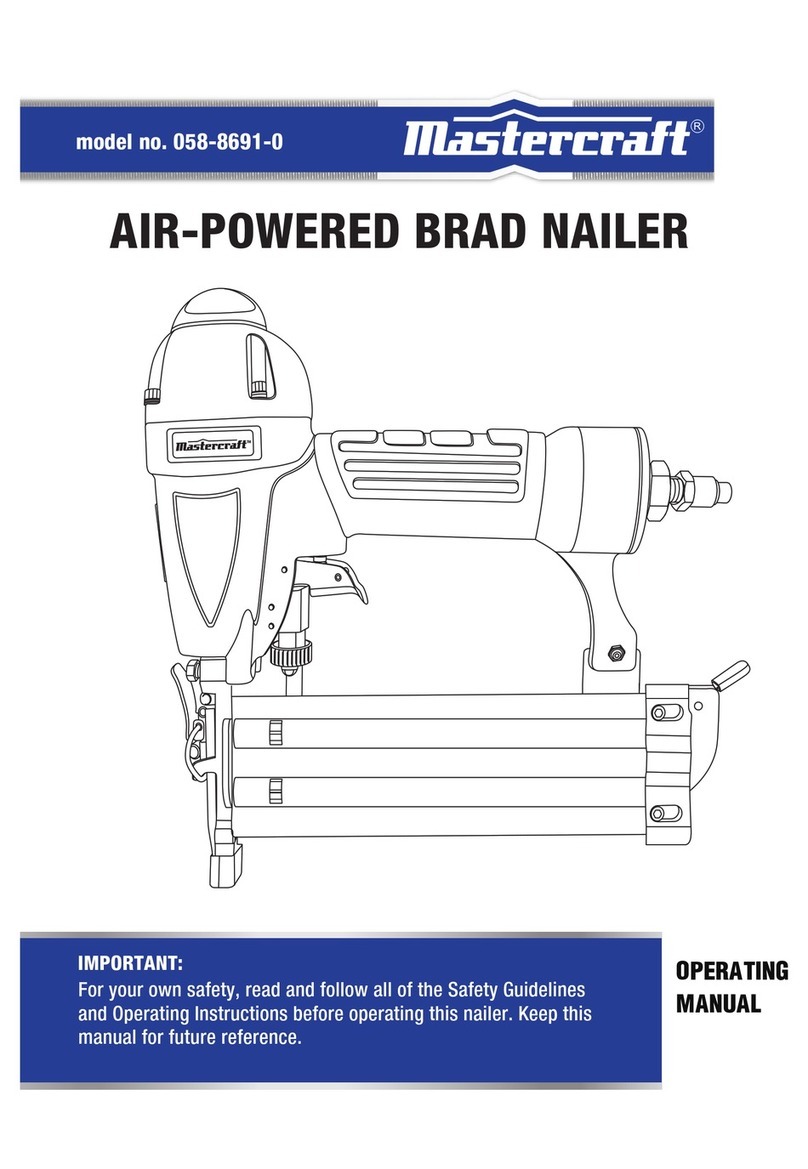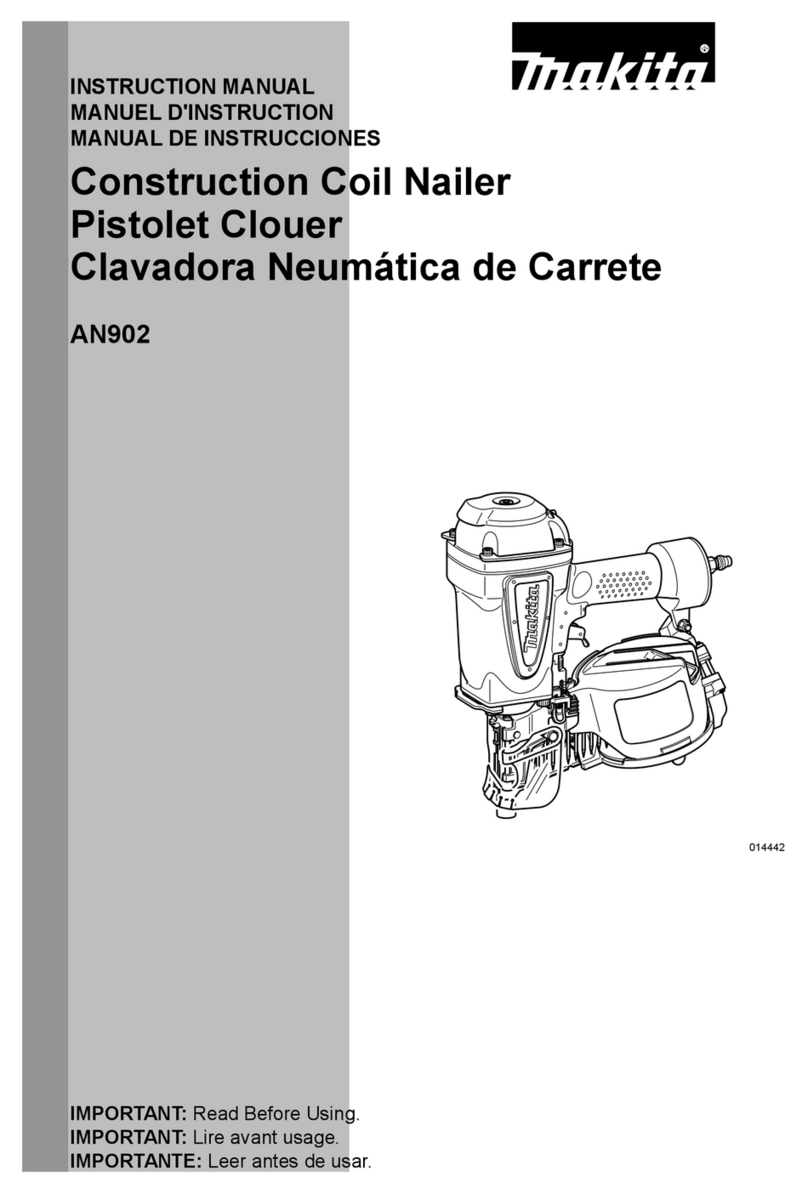Toua GBN 1850 Maintenance and service guide

!
!
GFN 1665
GBN 1850
Gas Brad Nailer Gas Finish Nailer
GBN 1850 GFN 1665
SAFETY OPERATING MANUAL

!
!
CONTENTS
SUBJECT
.................................................... PAGE
1.
S afety instructions............................................1
2.
Specification ......................................................6
3.
General Operation Manual .............................. 7
4.
Battery and Charger.......................................... 8
5.
Maintenance ....................................................17
6.
Servicing ............................................................20
7.
Troubleshooting.................................................. 21
8.
Exploded and Part List ............................ 22~25

!
!
IMPORTANT INFORMATION MUST BE READ
BEFORE USING THE TOOL
Read and understand tool labels
and all of operating instructions,
safety precautions and warnings in
this manual before operating or
maintaining this nailer.
Failure to follow warnings could result in DEATH
or SERIOUS INJURY.
Most accidents that result from the operation and
maintenance of Nailers are caused by the failure
to observe basic safety rules or precautions. An
accident can often be avoided by recognizing
a potentially hazardous situation before it
occurs, and by observing appropriate safety
procedures.
Basic safety precautions are outlined in the
“SAFETY” section of this Manual
Hazards that must be avoided to prevent bodily
injury or machine damage are identified by
DANGERS and WARNINGS on the Nailer and in
this Manual
Never use this Nailer for applications other than
those specified in this Manual.
DEFINITIONS OF SIGNAL WORDS
DANGER indicates an imminent hazardous situation
which, if not avoided, will result in death
or serious injury.
WARNING indicates a potentially hazardous
situation which, if not avoided, could
result in death or serious injury.
CAUTION indicates a potentially hazardous
situation which, if not avoided, may
result in minor or moderate injury, or
may cause machine damage.
NOTE emphasizes essential information.
EXPLANATION OF THE NAILING ACTION OF THE
TOUA NAILER
This tool has a FULL SEQUENTIAL ACTUATION
MECHANISM (on the nailer body mark del operator ).
First, press the push lever ( push lever be called
apart of the full sequential actuation mechanism)
against the workpiece; press down of the nailer,
and then pull the trigger to drive the nail. Follow
the same sequence to continue driving nails after
the push lever and trigger are return back in place.
SAFETY
IMPORTANT SAFETY INSTRUCTIONS FOR
USING NAILERS
READ ALL INSTRUCTIONS
This Nailer is powered by internal
combustion device.
This Nailer shall only be used with
dispensers for combustible gas
which are listed in this manual.
DANGER
1.
OPERATORS AND OTHERS IN WORK AREA
MUST WEAR SAFETY GLASSES WITH SIDE
SHIELDS.
When operating the Nailer, always
wear safety glasses with side
shields, and make sure others in
work area wear safety glasses.
Safety glasses must conform to the requirements
of American National Standards Institute,
ANSI Z87.1 and provide protection against flying
particles both from the front and side.
T he employer must enf orce t he use of
safety glasses by the Nailer operator and
others in work area.
2.
NEVER USE IN PRESENCE OF FLAMMABLE
LIQUIDS OR GASES.
This Nailer must not be used in a
combustible environment or in
presence of flammable liquids or
gases, e.g. lacquer, paint, benzine,
thinner or gasoline.
This Nailer produces hot exhaust gases that
may ignite flammable materials and produces
sparks during operation.
3.
DO NOT TOUCH AROUND THE EXHAUST
OUTLET.
This Nailer produces hot exhaust
gases that may flammable materials.
The push lever and nose will
become hot and get heated up after
prolonged or rapid use.
Do not touch with bare hands.
4.
EXPLOSION AND FIRE HAZARD.
The fuel cell is an aerosol dispensers
with flammable contents.
Pressured container and the
propellant will remain in the fuel cell.
Faillure to follow instructions may
result in explosion or fire.
1

!
!
WARNING
Keep the Nailer, fuel cells and battery
away f rom sunshine and from
temperature exceeding 120°F
(50°C).
Fuel cell and/or battery may burst,
releasing flammable gas.
Do not pierce or burn the container,
even after use.
Do not incinerate, refill, reclaim
or recycle the fuel cell.
Do not spray to a naked flame or any
incandescent material.
Keep away from ignition sources
No smoking.
Keep out of the reach of children.
9.
STORE NAILER PROPERLY WITH FUEL CELL
AND BATTERY REMOVED.
When not in use, the Nailer, fuel cell and battery
should be store in tool case and in a dry place.
Store indoorsattemperature41°F(5°C) ~ 77°F(25°C).
Keep the Nailer, fuel cell and battery out of
direct sunlight and out of in a vehicle.
Keep out of reach of children.
Look the storage area.
10.
KEEP WORK AREA CLEAN.
Cluttered areas invite injuries. Clear all work
areas of unnecessary tools, debris, furniture, etc.
11.
KEEP VISITORS AWAY.
Do not let visitors handle the Nailer.
All visitors should be kept safely away from
work area.
5.
NEVER POINT TOOL AT YOURSELF OR OTHERS
IN WORK AREA.
Always assume the Nailer contains
fasteners.
Never point the Nailer at yourself or
others, whether it contains fasteners
or not.
If fasteners are mistakenly driven, it can lead to
severe injuries.
Never engage in horseplay with the Nailer.
Respect the Nailer as a working implement.
6.
KEEP FINGERS AWAY FROM TRIGGER
WHE N NOT DR IV IN G FA ST ENERS TO
AVOID ACCIDENTAL FIRING.
Never carry the Nailer with finger on trigger
since you could drive a fastener unintentionally
and injure yourself or someone else.
Always carry the Nailer by the handle only.
7.
ALWAYS WEAR EAR AND HEAD PROTECTION.
Always wear ear protection to protect your ears
from loud noise.
Always wear head protection to protect your head
from flying objects.
8.
USE OUTSIDE OR WELL-VENTILATED AREAS.
This Nailer shall not be used in
enclosed or poorly ventilated areas.
This Nailer exhausts carbon monoxide
which is a danger to health when
inhaled.
Do not inhale.
2
12.
DRESS PROPERLY.
Do not wear loose clothing or jewelry as they can
be caught in moving parts.
Rubber gloves and nonskid footwear are
recommended when working outdoors.
Wear protective hair covering to contain long hair.
13.
CHECK PUSH LEVER BEFORE USE.
Remove fuel cell and battery, and then make
sure the push lever operates properly. Never use
the Nailer unless the push lever is operating
properly, otherwise the Nailer could drive a
fastener unexpectedly. Do not tamper with or
remove the push lever, otherwise the push lever
becomes inoperable.
14.
KEEP ALL SCREWS AND COVERS TIGHTLY
IN PLACE.
Keep all screws and covers tightly mounted.
Check their condition periodically.
Never use the Nailer if parts are missing or
damaged.
15.
DO NOT LOAD FASTENERS WITH TRIGGER
OR PUSH LEVER DEPRESSED.
When loading fasteners into the Nailer,
1)
do not depress the trigger;
2)
do not depress the push lever;
3)
keep the Nailer pointed downward.
16.
KEEP FACE, HANDS AND FEET AWAY FROM
FIRING HEAD DURING USE.
Never place your face, hands or feet closer than
8 inches (200 mm) from the firing head.
A serious injury can result if the fasteners are
deflected by the workpiece, or are driven away
from the point of entry.
120°F MAX
(50℃)

!
!
17.
PLACE NAILER PROPERLY ON WORKPIECE.
Do not drive fasteners on top of other fasteners
or with the Nailer at too steep of an angle; the
fasteners can ricochet and hurt someone.
18.
DO NOT DRIVE FASTENERS INTO THIN
BOARDS OR NEAR CORNERS AND EDGES
OF WORKPIECE.
The fasteners can be driven through or away
from the workpiece and hit someone.
19.
NEVER DRIVE FASTENERS FROM BOTH
SIDES OF A WALL AT THE SAME TIME.
The fasteners can be driven into and through
the wall and hit a person on the opposite side.
20.
CHECK FOR LIVE WIRES.
Avoid the risk of severe electrical shock by
checking for live electrical wires that may be
hidden by walls, floors or ceilings. Turn off the
breaker switch to ensure there are no live wires.
21.
DO NOT OVERREACH.
Keep proper footing and balance at all
times. Do not allowed operate the nailer
on the scaffold and ladder.
22.
NEVER USE NAILER WHICH IS DEFECTIVE
OR OPERATING ABNORMALLY.
If the Nailer appears to be operating unusually,
making strange noises, or otherwise appears
defective, stop using it immediately and arrange
for repairs by a TOUA authorized service center.
23.
TAKE FUEL CELL AND BATTERY OUT OF
NAILER WHEN:
1)
doing maintenance and inspection;
2)
clearing a jam;
3)
it is not in use;
4)
leaving work area;
5)
moving it to another location;
6)
handing it to another person.
Never attempt to clear a jam or repair the Nailer
unless you have taken fuel cell and battery out
of the Nailer and removed all remaining fasteners
from the Nailer.
The Nailer should never be left unattended since
people who are not familiar with the Nailer might
handle it and injure themselves.
24.
KEEP ALERT.
Operate the nailer only in good physical and mental
state.
Do not operate the Nailer when you are tired.
The Nailer should never be used by you if you
are under the influence of alcohol, drugs or
medication that makes you drowsy.
25.
HANDLE NAILER CORRECTLY.
Operate the Nailer according to this Manual.
Never allow the Nailer to be operated by children,
individuals unfamiliar with its operation or
unauthorized personnel.
26.
NEVER USE NAILER FOR APPLICATIONS
OTHER THAN THOSE SPECIFIED IN THIS
MANUAL.
27.
HANDLE NAILER CAREFULLY.
Do not drop the Nailer or strike the Nailer against
hard surfaces; and do not scratch or engrave
signs on the Nailer. Handle the Nailer carefully.
28.
MAINTAIN NAILER WITH CARE.
Keep the Nailer clean and lubricated for better
and safer performance.
29.
USE ONLY PARTS, ACCESSORIES OR
FASTENERS SUPPLIED OR RECOMMENDED
BY TOUA.
Unauthorized parts, accessories, or fasteners
may void your warranty and can lead to malfunction
and resulting injuries.
Only service personnel trained by TOUA,
distributor or employer trained personnel shall
repair the Nailer.
30.
NEVER MODIFY OR ALTER A NAILER.
Doing so may cause it to malfunction and personal
injuries may result.
3

!
!
IMPORTANT SAFETY INSTRUCTIONS FOR FUEL
CELL
DANGER
■
Fuel cell, fuel and propellant are flammable
under pressure.
Explosion / Fire Hazard
Must to follow all instructions
otherwise may result in fire and
explosion when handling dispensers
for combustible gas for the purpose
of storage, transportation, inserting into and
taking out of the tool and disposal.
■
Do not smoke when handling the fuel cell.
WARNING
Do not inhale its contents.
In case of being inhaled ; the person
affected should be taken into the
open air and brought into a comfortable
position.
Expanding gases cause low temperatures.
Fluid gases might cause injuries when getting
in touch with skin or eyes.
In case of contact with skin ; wash the contact
surface carefully with warm water and soap and
apply a skin cream when dry.
In case of contact with eyes ; rinse the open eyes
under running water.
Contact a doctor if necessary.
Store in well-ventilated area.
Store within 41°F (5°C) ~77°F(25°C)(e.g.
Do not store under the direct sunlight or in a
vehicle).
Do not expose to an open flame and sparks.
Do not puncture or open the fuel cell.
Do not refill, reclaim or recycle the fuel cell.
Dispose of according to local regulations for
aerosol products.
Do not dispose of fuel cell with other scrap for
recycling.
Keep out of reach of children.
IMPORTANT SAFETY INSTRUCTIONS FOR
BATTERY CHARGER
WARNING
Death or serious bodily injury could result from
improper or unsafe use of battery chargers.
To avoid these risks, follow these basic safety
instructions:
READ ALL INSTRUCTIONS
1.
This manual contains is important safety and
operating instructions for battery charger Model
504.4.04.010.XX.
2.
Before using battery charger, read all instructions
and cautionary markings on (1)nailer,(2) battery
charger, (3) battery.
3.
To reduce risk of injury, only use TOUA rechargeable
battery type504.4.04.011.08. Other type of
batteries may burst causing personal injury and
damage.
4.
Do not expose battery charger to rain or snow.
5.
Use of an attachment not recommended or sold
by the battery charger manufacturer may result
in a risk of fire, electric shock, or injury to persons.
6.
To reduce risk of damage to electric plug and
cord, pull by plug when disconnecting battery
charger.
7.
Make sure cord is located so that it will not be
stepped on, tripped over, or otherwise subjected
to damage or stress.
8.
An extension cord should not be used unless
absolutely necessary.
Use of improper extension cord could result in a
risk of fire and electric shock. If extension cord
must be used make sure:
a) That blades of extension cord are the same
number, size, and shape as those of plug
on battery charger;
b) That extension cord is properly wired and in
good electrical condition;
c) That wire size is large enough for AC
ampere
rating of battery charger as specified in table 1.
4

!
!
Table 1
RECOMMENDED MINIMUM AWG SIZE FOR
EXTENSION CORDS FOR BATTERY CHARGERS
AC Input Rating Amperes AWG Size of Cord
Equal to or but less than Length of Cord, Feet (Meter)
greater than 2.5(7.5) 50(15) 100(30) 150(45)
0 2
18 18 18
16
2 3 18 18 16
14
3 4 18 18 16
14
If the input rating of a battery charger is given in
watts rather than in amperes, the corresponding
ampere rating is to be determined by dividing the
wattage rating by the voltage rating-for example:
2,200 watts/220volt=10 Amperes
9.
Do not operate battery charger with damaged
cord or plug ,should replace them immediately.
10.
Do not operate battery charger if it has received
a sharp blow, been dropped, or otherwise damaged
in any way; take it to a qualified serviceman.
11.
Do not disassemble battery charger; take it to a
qualified serviceman when service or repair is
required.
Incorrect reassembly may result in a risk of
electric shock or fire.
12.
To reduce risk of electric shock, unplug charger
from receptacle before attempting any maintenance
or cleaning. Removing the battery will not reduce
this risk.
13.
Please read this Manual before using the battery
charger.
IMPORTANT SAFETY INSTRUCTIONS FOR USE
OF THE BATTERY AND BATTERY CHARGER
You must charge the battery before you use the
Nailer. Before using the model 503.1.16.001.01
battery charger, be sure to read all instructions and
cautionary statements on the battery and in this
manual.
REMEMBER : ONLY USE TOUA BATTERY
TYPE503.1.10.001.01.
OTHER TYPES OF BATTERIES MAY BURST
AND CAUSE INJURY!
Follow these instructions to avoid the risk of injury:
WARNING
Improper use of the battery or battery charger
can lead to serious injury. To avoid these injuries:
1.
DO NOT disassemble the battery.
2.
DO NOT incinerate the battery, even if it is
damaged or is completely worn out.
The battery can explode in a fire.
3.
DO NOT short-circuit the battery.
4.
DO NOT insert any objects into the battery
charger's air vents. Electric shock or
damage to the battery charger may result.
5.
DO NOT charge outdoors. Keep the battery away
from direct sunlight and use only where
there is low humidity and good ventilation.
6.
DO NOT charge when the temperature is below
50°F (10°C) or above 104°F (40°C).
7.
DO NOT connect two battery chargers together.
8.
DO NOT insert foreign objects into the hole for
the battery or the battery charger.
9.
DO NOT use a booster transformer when charging.
10.DO NOT use an engine generator or DC power
to charge.
11.
DO NOT store the battery or battery charger in
places where the temperature may
reach or exceed 104°F (40°C).
12.
MUST TO DO operate charger on standard
household electrical power (120 volts).
Using the charger on any other voltage
may overheat and damage the charger.
13.
MUST TO DO wait at least 15 minutes between
charges to avoid overheating the
charger.
14.
MUST TO DO disconnect the power cord from
its receptacle and cut off the charger
power when the charger is not in use.
DISPOSAL OF THE EXHAUSTED BATTERY
WARNING
Do not dispose of the exhausted battery. The
battery must explode if it is incinerated. The
product that you have purchased contains a
rechargeable battery. The battery is recyclable.
At the end of it's useful life, under various state
and local laws, it may be illegal to dispose of
this battery into the municipal waste stream.
Check with your local solid waste officials for
details in your area for recycling options or proper
disposal.
EMPLOYER'S RESPONSIBILITIES
1.
Ensure that this MANUAL is available to operators
and personnel performing maintenance.
2.
Ensure that Nailers are used only when operators
and others in work area are wearing EYE PROTECTOR.
3.
Enforce the use of EYE PROTECTOR by operators
and others in work area.
4.
Keep Nailers in safe working order.
5.
Maintain Nailers properly.
6.
Ensure that Nailers which require repair are not
further used before repair.
SAVE THESE MANUAL AND MAKE THEM
AVAILABLE TO OTHER USERS AND OWNERS
OF THIS TOOL!
5

!
!
SPECIFICATION
1.GAS FINISH NAILER
TYPE
GFN1665
GBN1850
Type of power
Piston reciprocating
Applicable nails
See Page14. Available Nails.
Nail Capacity
100 nails (2- strip)
100 nails (2- strip)
Ambient temperature
-5 ℃~ 50℃(23℉to 120℉)
Dimensions
11.81 "(L)×11.33"(H)×3.54"(W)
300mm (L)×288mm (H)×90mm (W)
11.41"(L)×11.33"(H)×3.54"(W)
290mm (L)×288mm (H)×90mm(W)
Weight
5.05lbs. (2.35kg Include battery )
4.65lbs.(2.15kg Include battery )
Cycle Rate
2nails/second
Battery Pack
Li-Ion DC 7.2V 1.5Ah
2.BATTERY CHARGER
Input Power Source
DC 12V
Charging Time
Approx. 150minutes
Charginger
Charging voltage.............DC 7.2V
Charging Current............DC 0.75A
Charging Weight
0.15kg
Adapter Weight
0.085kg
NOTE:
The charging time may vary according to temperature and power source voltage.
NOTE:
Choose the suitable nail length .
Choose overlong nail will cause the nail bending or the nail head emersion on the work piece.
Only nails shown in the Table above can be driven with this nailer .
3.
Fuel cell
6
Fuel Cell
Sold Separately, Specification as below:
1 )Φ31.5mm x 79mm Pressure 16 ~18 bar,
Using temperature range: 23 ℉(-5℃)~120℉(50℃ )
Model No: FC80-1-1

!
!
GENERAL OPERATION MANUAL
NOTE:
The information contained in this Manual is designed to assist you in the safe operation of the Nailer.
Some illustrations in this Manual may show details or attachments that differ from those on your own
Nailer.
NAME OF PARTS
1.
MODEL: GFN1665/GBN1850
Top Cover
2. Battery Pack(504.4.04.011.08)
Terminal
Battery Pack
Latch
3. Battery Charger(504.4.04.010.XX) (include Adapter and Charger Base)
Charger Base
Connection Receptacle
Adapter
Pilot Lamp
Power Cord
Air Vent Connection Plug
Power Plug

!
!
4. Accessories
1 2 3
4
1.
How to install the battery
Align the battery with the groove in tool handle
and slip it into place. Always insert it all the way
until it locks in place with a little click. If not, it
may accidentally fall out of the tool, causing
injury to you or someone around you.
2.
How to remove the battery
Withdraw battery from the tool handle while
pressing the button on the back of the battery.
DANGER
5 6 7
8
CHARGING METHOD
NOTE: Before plugging into the receptacle, make
sure the following points.
■
The power source voltage is stated on the nameplate.
■
The cord is not damaged.
Accessories other than those shown below can lead
to malfunction and resulting injuries.
STANDARD ACCESSORIES
1.
Safety Glasses·········································1
2.
Allen Wrench for M5 Screw························· 2
3.
Lubricant Oil ············································ 1
4. ···························································
No
se Cap(mounted on tool) ······························1
5.
Battery ························································
2
6.
Charger······················································
1
7.
Adapter·······················································
1
8.
Box ····························································
1
OPTIONAL ACCESSORIES
sold separately
1.Fuel Cell
2.Cleaner
(Code No. 504.6.04.001.01)
REMOVAL AND INSTALLATION METHOD OF
BATTERY
Latch
Handle
pull out
insert
WARNING
■
Do not charge at voltage higher
than indicated on the nameplat e.
If charged at voltage higher than
indicated on the nameplate, the
charger will burn up.
■
Do not use the electrical cord if damaged.
Have it repaired immediately.
■
TOUA charger(504.4.04.010.XX) only use for
TOUA battery (504.4.04.011.08), and TOUA
battery( 504.4.04.011.08 ) also only use for
TOUA charger( 504.4.04.010.XX ), if not, may
cause the charger damage or battery burst.
STEP:
1.
Insert the battery into the charger base. Make
sure it contacts the bottom of the charger base .
2.
Insert the connection plug of adapter into the
receptacle of the charge base.
3.
Insert the power plug of the adapter into the
plug seat.
4.
Charging
■
When the plug of charger adapter has been inserted
into the plug seat , charging will commence and the
green pilot lamp will light flash.
■
Approx. 200 min. at 70°F (20°C), when the
battery is fully charged, the green pilot lamp
light on.
■
Red flash & green light off,charging problem.
8

!
!
NOTE: The battery charging time becomes longer
when a temperature is low or the voltage of
the power source is too low.
When the green pilot lamp does not light on
even if more than three hours has passed
after start of the charging, stop the charging
and contact your TOUA AUTHORIZED
SERVICE CENTER.
5.
Disconnect battery charger from the power plug.
CAUTION
Do not pull the plug out of the receptacle by
pulling on the cord.
Make sure to grasp adapter plug when removing
from receptacle to avoid damaging adapter.
6.
Remove the battery from the battery charger.
Supporting the charger base with hand, pull out
the battery from the charger base.
Regarding electric discharge in case of new batteries, etc.
As the internal chemical substance of new batteries
and batteries that have not been used for an extended
period is not activated, the electric discharge might
be low when using them the first and second time.
This is a temporary phenomenon, and normal time
required for recharging will be restored by recharging
the batteries 2 - 3 times.
How to make the battery perform longer
1.
Do not recharge the batteries after they become
completely exhausted.
When you find the power pilot lamp change from
green to red on ther nailer handle, should stop to
operate the nailer and recharge its battery. If you
continue to use the nailer and exhaust the electric
current, the battery may be damaged and its life
will become shorter.
2.
Avoid recharging at high temperatures.
A rechargeable battery will be hot immediately
after use. If such a battery is recharged immediately
after use, its internal chemical substance will
deteriorate, and the battery life will be shortened.
Leave the battery and recharge it after it has cooled
for a while.
CAUTION
■
When the battery charger has been continuously
used, the battery charger will be heated, thus
constituting the cause of the failures. Once the
charging has been completed, give 15 minutes
rest until the next charging.
■
If the battery is recharged when it is warm due
to battery use or exposure to sunlight, the pilot
lamp may not light. The battery will not be
recharged. In such a case, let the battery cool
before charging.
■
If the battery charger does not work while the
battery is mounted correctly, it is probable that
the battery or charger is malfunctioning. Take
it to your TOUA authorized Service Center.
BEFORE OPERATION
Read section titled “SAFETY”
Make sure of the followings before operation.
WORKING ENVIRONMENT
WARNING
■
No flammable gas, liquid or other
flammable objects at worksite.
■
Use outside or well- ventilated
areas.Do not inhale.
■
Keep the Nailer, fuel cell and
battery away from sunshine and
from temperature exceeding
120°F (50°C).
■
Keep away from ignition sources.
No smoking.
■
Clear the area of children or
unauthorized personnel.
COLD WEATHER CARE
■
Do not store the Nailer, fuel cell and battery in a
cold weather environment. Keep the Nailer, fuel
cell and battery in a warm area until beginning
the work.
■
If the Nailer, fuel cell and battery are already
cold, bring it in a warm area and allow the Nailer
to warm up before use. Observe temperature
limit of max. 120°F (50°C).
Do not expose to an open flame and sparks!
CAUTION
■
This Nailer may not drive completely below
when:
at low temperature fuel cell loose the required
propellant force;
at high temperature fuel cell overdose.
■
Do not use the Nailer in the rain or where
excessive moisture is present.
■
This Nailer is not recommended for use at
altitudes above 5,000 feet (1,500 m), or in
temperature below 23°F (-5°C).
PREPARING THE FUEL CELL
Read section titled “FUEL CELL IMPORTANT
SAFETY INSTRUCTIONS ”
DANGER
■
The fuel cell is flammable.
■
Keep away from ignition sources.
9
120°F MAX
(50℃)

!
!
CAUTION
■
Do not spray to a naked flame or
any incandescent material.
■
Do not smoke when handling
fuel cell.
■
Keep stem of fuel cell away from
face or skin. Expanding gases
cause low temperatures. Do not
contact with gases.
■
Do not inhale.
■
Keep out of reach of children.
WARNING
Never use Nailer after taking off the magazine.
TESTING THE NAILER
DANGER
Operators and others in work area
MUST wear safety glasses with
side shields which conforms to
ANSI Z87.1 specifications.
WARNING
Never use Nailer unless push lever is operating
properly.
■
If the gas leaks from the metering valve or the
gas cartridge after attached the metering valve,
replace with the new metering valve.
■
Do not attempt to reuse the metering valve.
Replace with the new metering valve.
To attach the metering valve to a fuel cell.
Cap
The machine employs a preventive mechanism
for unloaded operation.
The machine enters a state where the push lever
cannot be pushed up. This takes place when the
magazine is not loaded with nails or when the
remaining number of nails becomes less than 2 or 3.
CAUTION
Use caution not to throw the push lever tip onto
any object.
Stem
Fuel Cell
Metering Valve
Before actually beginning the nailing work, test the
Nailer by using the checklist below. Conduct the
tests in the following order.
If abnormal operation occurs, stop using Nailer and
contact a our authorized service center immediately.
(1)
Separate the metering valve and the cap from
the gas cartridge.
(2)
Stem downward, put the metering valve inclined
forward to the bowl cover.
(3)
Press downward on the rear of the metering valve
until it seals, no gas leakage.
Check the metering valve:
Press the metering valve stem on fuel cell two
or three times against a stationary object and
release.
If gas is not dispersed, fuel cell is empty. Replace it. .
Observe Safety Regulations.
The fuel cell is now ready to insert into the Nailer.
PREPARING THE BATTERY
Read section titled “SAFETY, IMPORTANT
SAFETY INSTRUCTIONS FOR BATTERY
CHARGER”.
You must charge the battery before use.
The charging method of battery is shown as “Charging
Method” chapter.
(1) REMOVE ALL NAILS, FUEL CELL AND BATTERY
FROM NAILER.
■
ALL SCREWS MUST BE TIGHTENED.
10

!
!
BATTERY INDICATOR LIGHT
Indicated Light
■
THE PUSH LEVER AND TRIGGER MUST MOVE
SMOOTHLY with releasing the nail feeder.
Trigger
Flashing GREEN: Enough power remaining
(The light turns steady during operation).
Flashing RED: Insufficient power remaining
(The light turns steady during operation).
(3) INSERT FUEL CELL INTO NAILER.
① Pulling the latch and open the cell cover.
Latch
Nail Feeder
Push Lever
(2) Installing the battery.
② Insert the fuel cell into nailer.
Latch
Do not operate the push lever or trigger while installing
the battery.
Make sure the battery indicator light is flashing green.
If the battery indicator light is flashing red, the battery
doesn't have enough power and it needs to be charged.
11
Cell Cover
Fuel Cell
Handle
insert
Battery

!
!
③ Insert the stem of fuel cell into the hole of
adaptor.
■
THE NAILER MUST NOT OPERATE.
(5)
Separate the push lever from the workpiece.
Next, point the push lever downward and leave
workpiece, pull the trigger and then wait in that
position for 5 seconds or longer.
If burst, this means the push lever have not
replacing, the cylinder have not open, nailer is
anomaly.
Adapter
Stem
Fuel Cell
■
THE NAILER MUST NOT OPERATE.
(6)
Depress the push lever against the workpiece,
downward nailer, pull the trigger.
Stem
Pull the trigge
④ Close the cell cover.
⑤ Lock up the latch.
(4) Remove the finger from the trigger and press the
push lever against the workpiece with
releasing backward the nail feeder, motor fan start.
Do not pull
the trigger
Nail Feeder
■
THE NAILER MUST OPERATE.
(7)
If no abnormal operation is observed, you may
load nails in the Nailer.
Drive nails into the workpiece that is the same
type to be used in the actual application.
■
THE NAILER MUST OPERATE PROPERLY.
Depress push
lever against the
work piece
Nail Feeder
12
Cell Cover

!
!
LOADING NAILS
WARNING
■
When loading nails into Nailer,
1)
do not depress trigger;
2)
do not depress push lever;
3)
keep the Nailer pointed downward;
4)
Keep your face,hands feet and other body
parts,as well as those of other persons away
from the nose muzzle to avoid possible injury
uasge and carrying.
Nail Feeding Step
(1) Press the lock lever and gently pull out the
magazine cover
(3)
Slide the nail strip into the blade guide
Blade Guide
Lock lever
Magazine cover
(4)
Confirm that nail strips is placed with slide guide
groove properly,then push magazine cover forward
to be latched.
(5)
For GBN1850,always keep the point of nails in
contact with Groove,see Fig below.
Magazine
(2)
Set one or two nail strips into the magazine and
keep the rear of nails in contact with the silde groove.
Side guide
groove
Nail
Magazine
NOTE:
Groove
■
Quietly push the feeder knob to bring the nail
feeder to the end of the magazine, loosen the
feeder knob let the nail feeder slowly forward
against the nail.
■
The nails shown in page 14 can be loaded onto
the side guide groove of the magazine without
any adjustment
■
Use nail strip of more than 4 nails.
The Nailer is now ready to operate.
13
Gap

!
!
NAIL SELECTION.
Dimensions of Nails(MODEL:GFN1665)
THE CORDLESS 16 Ga STRAIGHT
FINISH NAILER DRIVES THESE NAILS
LENGTH
WHERE USED
!
3
4"(19mm)
Panel,Bead,Molding
!
1"(25.4mm)
Panel,Cap/Shoe Molding
!
1-1/4
"(32mm)
Cap/Shoe Molding
!
1-1/2
"(38mm)
Baseboard,Crown,Chair
!
1-3 4"(44.5mm)
Baseboard,Crown,Chair
!
2"(50.8mm)
Baseboard,Casings,Crown
!
2-1/4
"(57mm)
Casings
!
2-1/2
"(63.5mm)
Casings
Dimensions of Nails(MODEL:GBN1850)
THE CORDLESS 18 Ga BRAD NAILER
DRIVES THESE NAILS
LENGTH
WHERE USED
!
5/8"(15.8mm)
Cabinetry,Cove Molding,Shoe&Base
Molding,Undermeath Stair Tread,
Mitered Corner,Lattice Strip Moling,
Crown Molding Outside Corners,
Book Cases
!
1"(25.4mm)
Cabinetry,Cove Molding,Shoe&Base
Molding,Undermeath Stair Tread,
Mitered Corner,Lattice Strip Moling,
Crown Molding Outside Corners,
Book Cases
!
1-1/4
"(32mm)
Cabinetry,Shoe&Base Molding,
Scribe Molding,Crown Molding,
ook Cases
!
1-1/2
"(38mm)
Cabinetry,Shoe&Base Molding,
Risers,Stairs,Knee Wall,
Panel Installation,Wainscoting,
Chair Rail,Window Casings,
Door Casings,Book Cases
!
2"(50.8mm)
Cabinetry,Shoe&Base Molding,
Risers,Stairs,Knee Wall,
Panel Installation,Wainscoting,
Chair Rail,Spindles,Panel,
Window Casings,
Door Casings,Book Cases
14

!
!
REMOVING THE NAILS:
(1)
Pull the lock lever backward to release the
magazine cover ,it will be push back on end of
magazine cover stopper by spring force.
(2)
Midfinger press the catch, let the nails drop into
palm of the hand(see chart g).
WARNING
■
Do not touch around the exhaust
outlet with bare hands.
The push lever and nose will
become hot and get heated up
after prolonged or rapid use.
■
Do not allowed push and pull
push lever with hand, otherwise
will caused accidental firing,
hurt someone .
■
Explosion and fire hazard Keep
away from sunshine and from
temperature exceeding 120°F
(50°C).
■
Keep away from ignition source.
■
No smoking.
■
NEVER point tool at yourself or
others in work area.
■
Keep finger s AWAY from
trigger when not driving nails
to avoid accidental firing.
■
Use outside or well- ventilated
area.
■
Do not inhale its contents.
■
Do not use the electrical cord if
damaged. Have it repaired
immediately .
■
Never place your face, hands
or feet closer than 8 inches
(200 mm) from firing head when
using.
NAILER OPERATION
Read section titled “SAFETY”.
DANGER
■
Operators and others in work
area MUST wear safety glasses
with side shields which conforms
to ANSI Z87.1 specifications.
■
Never use in presence of flammable liquids
or gases.
■
Do not drive nails on the top of other nails or with
Nailer at too steep of an angle; nails can ricochet
and hurt someone.
■
Do not drive nails into thin boards or near corners
and edges of workpiece. Nails can be driven
through or away from workpiece and hit someone.
■
Never drive nails from both sides of a wall at
the same time. Nails can be driven into and
through the wall and hit a person on the
opposite side.
■
Never use Nailer which is defective or operating
abnormally.
■
Do not use Nailer as hammer.
■
Disconnect battery and fuel cell from Nailer
when:
it is not in use;
leaving work area;
moving it to another location;
handing it to another person.
■
Be careful of unwanted fastener.
If the nailer can not normal driving nail at the
temperature below 23°F (-5°C), downward push
lever against to the workpiece, quick press
15
Lock lever
120°FMAX
(50℃)

!
!
downward nailer 2~3 times, pulling the trigger ,
the nails will be driven. Or use after put the
nailer and fuel cell indoor 30 minutes.
This Nailer is equipped with a FULL SEQUENTIAL
ACTUATION MECHANISM.
Explanation of FULL SEQUENTIAL ACTUATION
MECHANISM nailing operation:
First, press the push lever against the workpiece;
Next, press downward nailer;
Then, pull the trigger to drive a nail.
The machine employs a preventive mechanism
for unloaded operation.
The machine enters a state where the push lever
cannot be pushed up in place. This takes place
when the magazine is not loaded with nails or when
the remaining number of nails becomes less than 2
or 3.
CAUTION
Use caution not to press the push lever tip against
to the workpiece when the push lever cannot be
pushed up in place.
METHODS OF OPERATION
This Nailer is equipped with the push lever and does
not operate unless the push lever is depressed upward
top dead center position.
It is intermittent operation (Trigger fire) only.
Push lever
against the
workpiece firmly
Trigger
(1)
Position the nail outlet on the workpiece with finger
off the trigger.
(2)
Depress the push lever firmly until it is completely
depressed.
(3)
Pull and squeeze the trigger to drive a nail.
(4)
Remove finger from the trigger.
To continue nailing in a separate location, move
the nailer along the workpiece, repeating above
steps (1) -(4) as required.
Nail Jam Remove
In fire process meet the nail jam malfuction,remove
it according the following steps:
(1)
Remove the fuel cell and the battery;
Fuel cell
Battery
(2)
Remove all nails;
(3)
Loose the lock lover;
Lock Lever
Guide Plate
(4)
Remove the jammed nail with a slotted-head
screwdriver;
(5)
Close guide plate and latch , reinsert the fuel
cell and battery pack, then can continue firing.
USING THE NOSE CAP
WARNING
When attching or detaching the nose cap, be sure
to remove your finger from the trigger and
remove the fuel cell and the battery from nailer.
16

!
!
If you like to protect the surface of workpiece
against scratches or markings made by the push
lever,attach the accessory nose cap to the push
lever.
(1)
Remove the fuel cell and battery from the nailer;
(2)
Put the nose cap to the toe of push lever;
(3)
The nose cap is marked to indicate the exit
point of nail, making alignment easier;
(4)
When not using the nose cap, secure in the
stroage compartment.
Nose Cap
MAINTENANCE
NOTE:
■
The information contained in this Manual is designed
to assist you in the safe maintenance of the Nailer.
■
Some illustrations in this Manual may show details
or attachments that differ from those on your own
Nailer.
MAINTENANCE AND INSPECTION
Read section titled “SAFETY”.
DANGER
■
Never use and test in presence
of flammable liquids or gases.
■
Keep away from ignition source.
■
No smoking.
USING THE HOOK
CAUTION
Push Lever
WARNING
Remove fuel cell, battery and all nails from Nailer
when:
Daily cleaning;
Maintenance and Inspection;
Using the hook, can hang on the nailer to the work
belt or scaffolding on work.
Hook
If the tool falls, there is a risk that malfunctions or
parts damage can occur.
It is recommended that you also use fall- preventing
wires, etc.
Clearing a jam.
1.
Daily cleaning
Must regularly to clean nailer, remove the internal
accumulation of smeary, carbon and dust, and to
ensure the normal operate, extend nailer working
life. Please use TOUA designated cleaner
(504.6.04.001.01).
Follow the attachment Gas Finish Nailer
Cleaning Guide-a steps and methods to clean
the nailer.
TOUA nailer cleaning interval depends on the
nailer operating environment and the firing quantity
per week of nails. If using at the dirty environmental
and firing large quantity per week, nailer cleaning
intervals will be shorter.
Below is the cleaning interval for you reference.
If you according to the cleaning interval to clean
the nailer. If find the nailer is extremely dirty, the
cleaning interval should be shorten, conversely,
if find ther nailer is very clean, extend cleaning
interval.
17

!
!
APPLICATIONS
The TOUA Cordless 16 ga. Straight Finish Nailer is suited for a varity of applications. These include
securing door and windows casings; attaching baseboards where walls meet floors; attaching moldings
where walls meet ceilings; securing paneling; securing chair rails, picture molding and other decorative
trim.
18
Door Stop
Window Casings
Crown Molding
Hand Rail
Door
Casings
Chair Rail
Cabinets
Apron
Stairs
Door Jamb
Paneling
Wainscoting
Baseboard Molding,
Cap & Base Shoe
This manual suits for next models
1
Table of contents
Other Toua Nail Gun manuals
